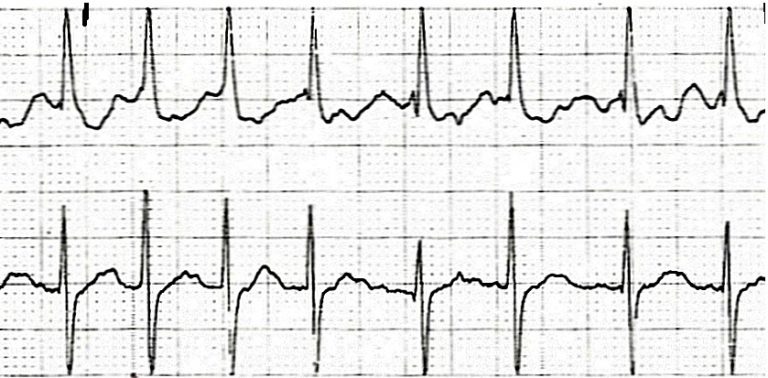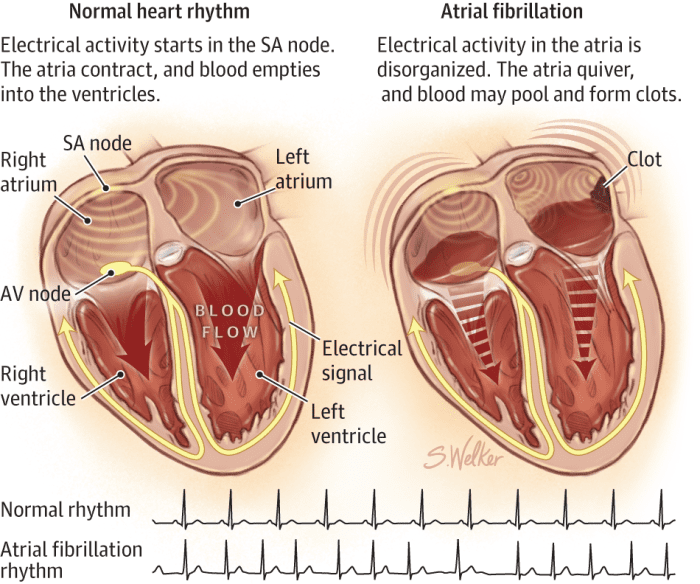
But rarely does it persist for months or years. It is typically not a stable rhythm, and often degenerates into atrial fibrillation (AF). high blood pressure, coronary artery disease, and cardiomyopathy) and diabetes mellitus, it may occur spontaneously in people with otherwise normal hearts. Symptoms may include a feeling of the heart beating too fast, too hard, or skipping beats, chest discomfort, difficulty breathing, a feeling as if one's stomach has dropped, a feeling of being light-headed, or loss of consciousness.Īlthough this abnormal heart rhythm typically occurs in individuals with cardiovascular disease (e.g. Atrial flutter is characterized by a sudden-onset (usually) regular abnormal heart rhythm on an electrocardiogram (ECG) in which the heart rate is fast. When it first occurs, it is usually associated with a fast heart rate and is classified as a type of supraventricular tachycardia. Avoid binge drinking.Atrial flutter with varying A-V conduction (5:1 and 4:1)Ītrial flutter ( AFL) is a common abnormal heart rhythm that starts in the atrial chambers of the heart. Talk to your health care provider about steps to treat conditions that cause atrial fibrillation/flutter. It may come back even with treatment.Ĭlots that break off and travel to the brain can cause a stroke.Ĭall your health care provider if you have symptoms of atrial fibrillation or flutter. Many people with atrial fibrillation do very well.Ītrial fibrillation tends to return and get worse. Treatment can often control this disorder.
#Atrial flutter atrial fibrillation how to#
You may need a heart pacemaker after this procedure.Īll people with atrial fibrillation will need to learn how to manage this condition at home. Your doctor will consider your age and other medical problems when deciding which drug is best.Ī procedure called radiofrequency ablation can be used to destroy areas in your heart where the heart rhythm problems originate. Antiplatelet drugs such as aspirin or clopidogrel may also be prescribed. These drugs increase the chance of bleeding, so not everyone can use them. They include heparin, warfarin (Coumadin), apixaban (Eliquis), rivaroxaban (Xarelto), and dabigatran (Pradaxa). Atrial fibrillation returns in many people even while taking these medicines.īlood thinners are medicines that are used to reduce the risk of developing a blood clot traveling in the body (such as a stroke). These drugs work well in many people, but they can have serious side effects. Prevent atrial fibrillation from coming back. These drugs may include beta-blockers, calcium channel blockers, and digoxin. These treatments may be done as an emergency, or planned ahead of time.ĭaily medicines taken by mouth are used to: Tests to study the heart’s electrical systemĬardioversion treatment is used to get the heart back into a normal rhythm right away. Tests to examine the blood supply of the heart muscle The monitor records the heart’s rhythms over a period of time.Įchocardiogram (ultrasound imaging of the heart) If your abnormal heart rhythm comes and goes, you may need to wear a special monitor to diagnose the problem. Blood pressure may be normal or low.Īn ECG (a test that records the electrical activity of the heart) may show atrial fibrillation or atrial flutter. In atrial fibrillation/flutter the heart rate may be 100 – 175. Your pulse may feel fast, uneven, or both. The health care provider may hear a fast heartbeat while listening to your heart with a stethoscope. Sensation of feeling the heart beat ( palpitations) Pulse that feels rapid, racing, pounding, fluttering, irregular, or too slow This is because atrial fibrillation may stop or start on its own.

You may not be aware that your heart is not beating in a normal pattern. Overactive thyroid gland ( hyperthyroidism) Heart valve disease (most often the mitral valve) They become more common with increasing age.Ĭommon causes of atrial fibrillation include: These problems can affect both men and women.

In atrial flutter, the ventricles (lower heart chambers) may beat very rapidly, but in a regular pattern. Parts of the heart cannot contract in an organized pattern.Īs a result, the heart cannot pump enough blood to meet the body’s needs. These signals help your heart pump the right amount of blood for your body’s needs. The electrical signal that tells your heart to contract begins in an area called the sinoatrial node (also called the sinus node or SA node). When working well, the four chambers of the heart contract (squeeze) in an organized way. The heart rhythm is fast and irregular in this condition. Atrial Fibrillation or flutter is a common type of abnormal heartbeat.


 0 kommentar(er)
0 kommentar(er)
